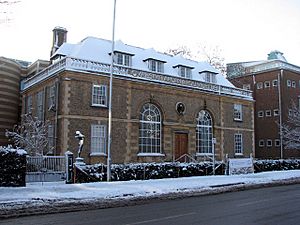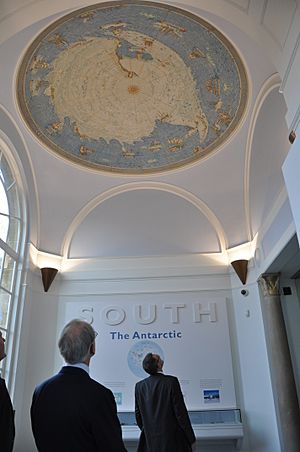Scott Polar Research Institute facts for kids
 |
|
| Established | 1920 |
|---|---|
| Director | Dr Neil Arnold |
| Location |
Cambridge
,
United Kingdom
52°11′54.40″N 0°07′34.45″E / 52.1984444°N 0.1262361°E |
The Scott Polar Research Institute (SPRI) is a special place in Cambridge, UK. It is part of the University of Cambridge. SPRI is a world-leading center for studying the polar regions and ice and glaciers.
It was started in 1920 by Frank Debenham. It was built to remember Captain Robert Falcon Scott and his team. They sadly died returning from the South Pole in 1912.
SPRI studies many things about the Arctic and Antarctic. This includes how the environment works, how people live there, and their history and art. The Institute has about 60 people working there. These include scientists, librarians, and students. It also hosts the Scientific Committee on Antarctic Research.
Contents
Studying the Polar Regions
SPRI has different groups that study the polar regions. They look at how ice and snow behave. They also study how people and nature interact in these cold places.
Ice and Climate Change
This group studies the world's ice and snow, called the cryosphere. They use satellites to see how much ice there is. They also take measurements on the ground and use computers to understand changes.
They have seen big changes, like the melting of the Larsen Ice Shelf. They also noticed ice melting quickly in western Antarctica. This work helps us understand climate change better.
Ice and Ocean Environments
This group looks at how huge ice sheets move. They also study how dirt and rocks from ice get into the ocean. They use special ships called icebreakers to gather information from the polar seas.
Polar Landscapes and Remote Sensing
This group studies how polar environments change. They look at plants in the Arctic and how snow and ice cover the land. A big part of their work is using satellites to measure plants.
Polar People and Cultures
This group studies the history, art, and people of the Arctic. They look at how people manage the environment and politics in polar areas. They know a lot about the culture and politics of the Russian North.
The Polar Museum
SPRI also has the Polar Museum. It shows many interesting items from the Institute's collections. These include objects, artworks, and photos from polar history. You can learn about exploration, science, art, and Arctic cultures.
The museum was updated and reopened in 2010. It was even nominated for the Art Fund's Museum of the Year award in 2011.
Inside, you can see displays about Arctic art. There are also items from the search for the Northwest Passage. You can see things from the "Heroic Age" of Antarctic Exploration. This includes the last letters of Captain Scott. The museum also shows current research about the polar regions.
The museum often has special exhibits. It is usually open from Tuesday to Saturday, and on Sunday afternoons. Entry is free for everyone. It is one of eight museums that are part of the University of Cambridge Museums.
Cool Things to See
The Polar Museum has many important items. They show the stories of people involved in polar exploration. Some of these include:
- A folding camera used by Robert Falcon Scott at the South Pole in 1912. This was during his British Antarctic Expedition.
- A sleeping bag made of reindeer skin. Captain Lawrence Oates used it on the journey to the South Pole. A search party found it in 1912.
- A sextant used by Captain Frank Worsley for navigation. He used it on the James Caird during Ernest Shackleton's expedition.
Artists in the Collection
The museum has art and photos by many famous artists. These include:
- Herbert Ponting
- Kenojuak Ashevak
- Kathleen Scott
- Edward Adrian Wilson
- Isobel Wylie Hutchison
- Sidney Nolan
- Frank Hurley
- Pudlo Pudlat
SPRI also adds new art through its artist-in-residence program. An artist travels to the Arctic or Antarctic each year.
Library and Collections
The Scott Polar Research Institute has the world's best polar library. It also has amazing archives. The Thomas H. Manning Archive has many old papers. These are about research and exploration in the polar regions.
The library has books and information about the Arctic and Antarctic. It also covers ice and snow everywhere. It's a great place for scientists and students to find information. It also helps industries learn about natural resources in cold places. It helps with designing ships that can break ice.
The Picture Library has many photos from both the Arctic and Antarctic. They show the history of polar exploration. This includes many pictures from the expeditions of Scott and Shackleton. The Thomas H. Manning Polar Archives are named after a British-Canadian Arctic researcher. They also record interviews with people who have worked in the polar regions. You need to book ahead to see materials in the archives.
The newest part of the library is the Shackleton Memorial Library. It won an award in 1999. This part holds many books about the Antarctic.
The library is part of the Polar Libraries Colloquy. This is a group of librarians who collect information about the Arctic and Antarctic. Anyone interested in the polar regions can use the library for research.
History of SPRI
The idea for a polar research institute came from Frank Debenham. He thought of it in 1912 while climbing Mount Erebus. This was during Robert Falcon Scott's Terra Nova Expedition.
After World War I, Debenham started the Institute with Raymond Priestley. Debenham was its first director.
The main building was built in 1933–1934 by Sir Herbert Baker. The small halls inside have cool domed ceilings. They are painted to look like the Earth from the North and South Poles. The gardens outside have sculptures and old items from the polar regions.
Past Directors
- 1920–1946: Frank Debenham
- 1937–1949: Launcelot Fleming
- 1949–1956: Colin Bertram
- 1958–1982: Gordon de Quetteville Robin
- 1982–1983: Terence Armstrong
- 1984–1987: David Drewry
- 1987–1992: Peter Wadhams
- 1992–1998: John Heap
- 1998–2002: Keith Richards
- 2002–2021: Julian A. Dowdeswell
- 2021–: Neil Arnold
Images for kids
See also
 In Spanish: Instituto Scott de Investigación Polar para niños
In Spanish: Instituto Scott de Investigación Polar para niños




